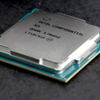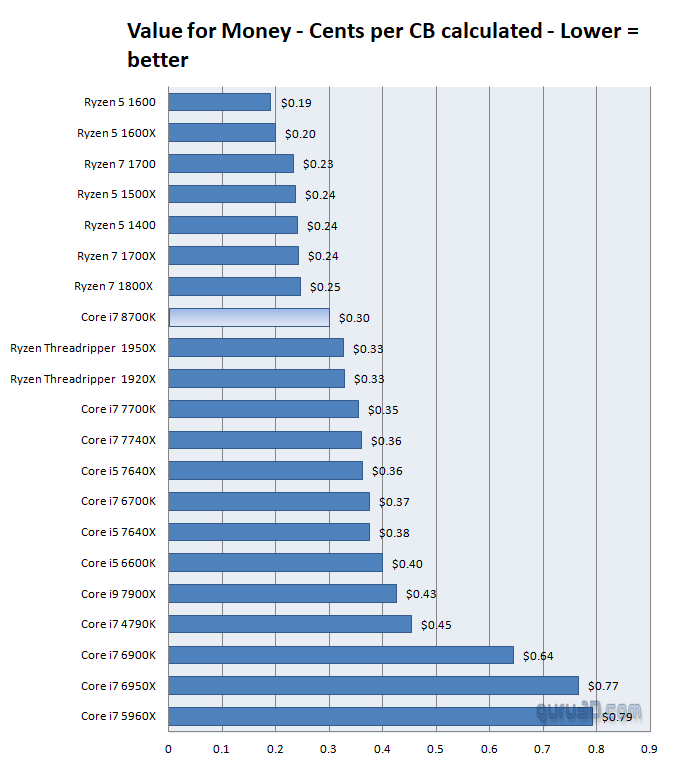Final Words & Conclusion
Conclusion
Intel's new Core i7 8700K manages to impress. Strictly speaking though as you have seen, if you look at IPC at 3500 MHz then Coffee Lake certainly isn't faster compared to the previous gen product. However, Intel benefits greatly from the fact that they can reach high clock frequencies. Turbo mode 3.0 remains a bit of a gimmick, little software is totally single threaded these days, but it places 4.7 GHz on the box packaging with big chocolate letters which is great for their marketing. Realistically though, Intel reaches 4.3 GHz on all six cores, that fact by itself is still impressive and is also where the extra performance comes from. In a default non-overclocked setup, the platform also manages heat and power consumption at very acceptable levels.
Performance & tweaking
We tested multiple Z370 motherboards all with the latest BIOS. I'd rate the new 6-core processor as 'very good' for the results as tested. Temps are fine under default circumstances and clocks frequencies. Once tweaked we noticed that the six cores like extra voltage, we expect all-core tweaks in the 5 GHz marker to need 1.35V with higher tweaks in the ~1.38 Volts ranges on the processor. While that does increase power consumption significantly, it wasn't something that scared me away. Temps at such voltages reach the 80 to 90 Degrees C marker. We, however, did use an ES sample, perhaps the final retail product can do with a little less juice. Overall though, we did manage to reach 5.2 GHz on all six cores stable, and that is impressive. If you plan a tweak at that 5 GHz marker then remember my remarks on cooling, you will need LCS, that or a very good heat pipe cooler. Again, we have been using an Engineering Sample so I cannot say anything conclusive on the final retail products (these might run a tiny bit cooler). The infrastructure that Z370 offers is easy to use, you increase the CPU voltage and multiplier and you are good to go. Another plus for the Intel platform is that over the years they have been able to refine their memory controllers, pop in anything XMP 2.0 and you have a 90% chance it'll work straight out of the box with very fast memories. Mind you that all our tests are performed at 3200 MHz DDR4, similar to Ryzen and Threadripper to remain objective and for fair play on both sides.
Power consumption
With this six cores and twelve threaded proc you get a 95 Watt TDP processor. With the system at idle with a GeForce GTX 1080 installed / 16 GB memory / SSD and the Z370 motherboard, I hovered at roughly 50 Watts in IDLE. That's just fine and normal really, but the load values are okay as well. When we stressed the processor 100% run we reach roughly 150 Watts with this 6-core part. When we game we hover at ~250 Watts with the GeForce GTX 1080, but obviously that factor is dependent on the type of graphics card you use of course and sure, most games certainly do not utilize the six CPU cores. Overall I have no worries here.
Prices and value
So in the above a mathematical plot, we take the CB score from CineBench 15. We normalize the value and basically plot how much money it takes to calculate the CB score. All processors are clocked at default frequencies, this plot would look different if you'd math in tweaked clock frequencies and thus get higher CB scores. Also, you need to take the number of CPU cores into account (as in what number of CPU cores is relevant for you). But this is very simple math, have a peek at the chart (the higher a CPU is positioned the better).
So what are you seeing?:
- An 8-core Core i7 5960X costs 79 cents per calculated CB.
- An 8-core Ryzen 7 1800X costs 25 cents per calculated CB.
- A 6-core Ryzen 5 1600 costs just 19 cents per calculated CB.
- A 6-core Core i7 8700K costs just 30 cents per calculated CB.
- A Core i9 7900X costs 42 cents per calculated CB.
This is a fairly arbitrary subjective chart as it is based on just one test, but it does paint a certain picture. And please do not confuse the chart as to 'what is the better processor'.
DDR4 Memory
For Coffee Lake (8th Gen Intel procs) DDR4 may be clocked a notch faster at 2400 MHz as per Intel reference. We always say, volume matters more than frequency. A 3,200 MHz kit, for example, is far more expensive and does offer better bandwidth but the performance increase in real-world usage will be hard to find. Unless you transcode videos over the processor a lot. As always, my advice would be to go with lower clocked DDR4 memory with decent timings, but get more of it. Don't go for 8 GB, get four DIMMs and in total a minimum of 16 GB. The reason we test at 3200 MHz is simple, we do the same for AMD Ryzen and want to create a fair and equal playing ground for both.
Final words
With Coffee Lake, Intel has a very fast processor series offering available for the masses. You can complain about pricing in comparison to the much cheaper Ryzen 5 1600X (229 EURO) but purely seen from a performance perspective, the Core i7 8700K is absolutely the winning product. Value for money wise though, the win is for AMD as you cannot beat what they are doing. Whether or not the extra performance is worth the extra money for you though is something only you can decide. Coffee Lake is a sound architecture though, we see decent temps and power consumption and where the X299 platform launch was a dreaded mess, the Z370 / Coffee Lake launch feels much more refined. We didn't run into any weird issues whatsoever. Performance wise the 8700K proc has it all, fast game performance and very nice tweakabilty (aside from temps at +1.350V and higher voltages). I have stated this many times, I feel quad-core processors are becoming last years news, hence Intel could not have been any later on the market with the new 6-core parts, an 8-core or 6-core processor is where you need to be. Not even necessarily for gaming, but it does make a difference in your overall windows experience alright. Windows 10 feels snappier and faster and with everything we do these days like watching movies and YouTube while streaming stuff like music and sharing content that does matter. The year 2017 is an exciting year in the processor arena. There are many things happening from the two primary brands, both keep each other in line and for the first time in a long time, both offer something very competitive and AMD Ryzen and its platforms currently are really good. So more or less cores? Again, in my opinion, the age of the quad-core processor is a dying one. AMD sparked and ignited something in the processor and developer landscape with the release of affordable Ryzen 8-core parts. If you look for more value, I find the 6-core parts to be the better balance for what is realistic for today's gaming PCs relative to pricing. Worthy of note is that we actually reached 5200 MHz on all cores. It was stable enough offering acceptable enough temps wise with our sample at hand. This processor offers 16 PCI Express Gen 3.0 lanes for graphics. The chipset will add more for your storage. DDR4 memory up-to roughly 4 GHz can be installed (dual-channel) depending on motherboard support of course. So yes, we had little to no issues with the proc and Z370, everything ran as expected and performed even better. More expensive yes, but recommended for sure. Your choice, other than that I certainly like what we have tested here today.
Note: article charts have been updated based on newer BIOS.
Handy related downloads:
- Sign up to receive a notice when we publish a new article
- Or go back to Guru3D's front page.




